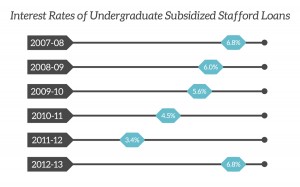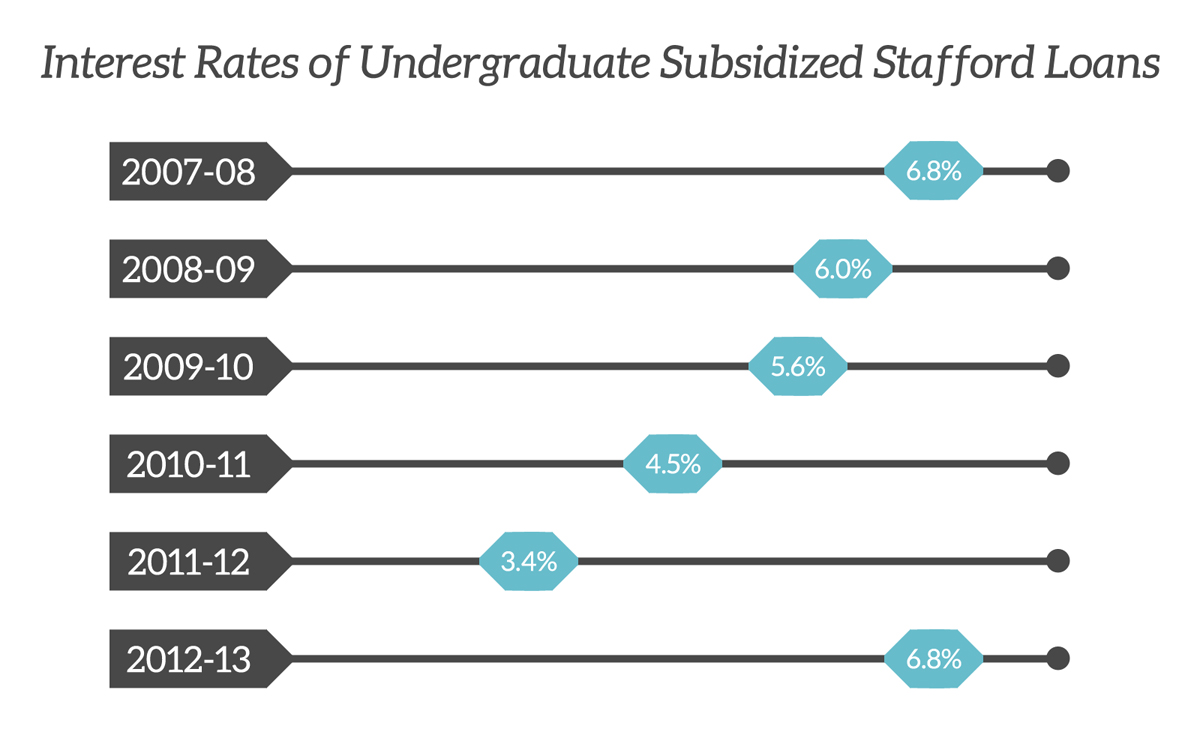
Congress has until July 1 to figure out how it is going to deal with the impending increase in student loan rates. If a proposal is not drawn up and the politicians on Capitol Hill decide to ignore the issue, then the rates will double from the current 3.4 percent to 6.8 percent. The hike may sound bad, as if it will have a great impact on students who depend on Stafford loans. But the truth is that the rise in loan rates will not have any damaging effects and the changes will be minor.
The two most popular student loans are the subsidized Stafford loan and the unsubsidized Stafford loan. The baseline rates for each are currently 3.4 percent and 6.8 percent, respectively. The subsidized Stafford loan’s interest rate, an extremely common loan that is typically offered to students whose parents make less than $70,000 a year, has been decreasing for the past six years. The recent debacle over the possible increase makes the looming transition—from 3.4 percent to 6.8 percent—seem worse than it actually is as a result. What people fail to remember is the subsidized Stafford loan was 6.8 percent a mere six years ago.
For those unfamiliar with the system involved in student loans, loans accepted from previous years will not be affected. The 6.8 percent hike will only affect those who are planning on taking out loans for the 2013-2014 school year—good news for the soon-to-be graduates. Subsidized Stafford loans borrowed in the past will not be affected since their interest rate remains at the percentage set during the years borrowed. So, there will be a minor increase for continuing students who expect to borrow a subsidized Stafford loan. Unsubsidized Stafford loans are not involved in the increase since they have always remained at 6.8 percent. But the small rise in subsidized loans will not exceed what it has been in the past.
In perspective, the loan increase is hardly anything substantial. Mark Kantrowitz, creator of the informative website FinAid.org, explained that the average subsidized Stafford loan at 6.8 percent would be $3,357 during the time that the rate remains as such. The impact on loan debt for students would be $761 extra in repayment obligations over a 10-year period. If you do the math, this comes out to be about $1.58 a week. This is of course just an average, but this increase is hardly detrimental on the education system, especially if the 6.8 percent hike only lasts for one year.
The message here is for students to realize that there is no substantial incoming negative effect that is going to put a strain on their financial obligations. This does not mean that the percent increase should be accepted with open arms. Yes, the rise in loan rates is not a significant worry. However, any increase that can be prevented should be prevented. The reason for this is simple: if we students can owe less money then why not owe less money?
The increase to 6.8 percent has been prevented before, but it would not be a surprise if the higher rate becomes the standard for the 2013-2014 school year since it has been so for years prior. Although students could end up paying a menial $6 more a month just for that year, Congress is attempting to deal with the issue. For instance, Representative Joe Courtney (D-Conn.) has proposed legislation that would postpone the loan hike for two years. This sounds like a worthwhile idea that could give politicians time to figure out what exactly they want to do about the increase in student loans.
This does not mean that all the suggested ideas are good ideas, though. The extension of the 3.4 percent rate for two years is a solid proposal for the time being, but President Barack Obama’s plan is in no way sufficient due to the fact that he has called for a market-based rate proposal. Lynn O’Shaughnessy of CBS’s “Money Watch” proclaims that Obama’s plan would stop the hike temporarily, but the Congressional Budget Office (CBO) has made clear that despite the short-term prevention of a rising subsidized Stafford loan rate, under a market-based solution, “the unsubsidized Stafford Loans would exceed their current 6.8 percent cap by 2016 and then top eight percent by 2018.” Postponing one increase means allowing for another loan rate to rise instead.
The problem with Obama’s plan is that a market-based rate proposal could lead to unexpected hikes, and even though there is an 8.25 percent cap on Stafford loans, I would be more satisfied with remaining at the usual 6.8 percent. For now, Courtney has the better proposal at hand.
Perhaps students will see an increase in their student loans, but this is not unprecedented, since it has been this rate before and was even expected as of last year. Students will also see no significant financial burdens. The hope for the time being is to see if Congress will be able to keep the 3.4 percent rate intact for a couple more years. If not, why worry about a few missing quarters from the piggy bank?








